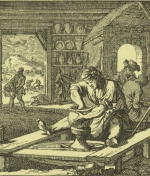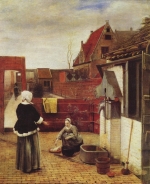Rotterdamse Poort and Schiedamse Poort
in the city's south wall near the southwest corner, where the Schie begins
Due to Vermeer's View of Delft (below), the Rotterdamse Poort and Schiedamse Poort are the best known of Delft's gates. The view is from the south looking over the Kolk, so the Rotterdamse Poort is on the right and the Schiedamse Poort is in the center.

Rotterdamse Poort
The map of 1560 (upper right) is a view from the east that shows a single gate and the Schie canal beginning east of the gate. It was referred to as the Wittenvrouwenpoort for the nearby nunnery. Construction began in 1396 and was not completed until 1514.
When the city was fortified at the beginning of the was of independence from Spain in the mid-1500's, this whole area was rebuilt to better defend against warships coming from the south that took the Schie, the shortest route from the North Sea to Delft. Blaeu's Delft Batavorum map of 1649 (middle right; click to enlarge) is a view from the west that shows both the Rotterdamse Poort and the Schiedamse Poort, referred to by their earlier names, St. Jacobs Poort and Zuijdpoort (Zuijd = south). Also the singel has been widened and a dock built for the ferry to Delfshaven and Rotterdam.
|
1560 |
|
1649 |
|
1678 |
These were the busiest gates because they led to the Schie canal that went south for a couple of miles before a similarly wide and deep canal split off to the west to find the Maas River very close to the North Sea. The Schie canal continued south to the village of Overschie, where a branch split off east to Rotterdam and another split off west to Schiedam. The main canal continued straight south to Delfshaven. Rotterdam, Delfshaven, and Schiedam were all on the Maas River only a few miles from the North Sea.
Delft's prosperity depended in large part on
- being one of only six cities with an office of the Dutch East-India Company
- having an office of the Dutch West India Company
That meant ship traffic, lots of it. By 1614, Delft's business community and its city government began digging out the Kolk, the little open area of water in the foreground of Vermeer's painting. Finished by 1620, it was seldom that empty. The Kaart Figuratief (lower right; click to enlarge) of 1678 shows it full of masted boats as well as passenger and cargo barges (trekschuiten). There was a ship-building and ship-repair area on the east bank of the Schie not shown here.
Sails were clearly of limited use on the narrow canal. The seagoing vessels that were not going up the Schie canal were off-loaded in Delfshaven, Rotterdam, or Schiedam. Horse-drawn canal barges transported their cargo the eight miles north to Delft and returned with baskets and barrels of goods to export around the world.
The Rotterdamse Poort served two purposes. It stuck out into the singel, leaving room for only smaller boats to pass in the direction of the Oostpoort. It also had a short drawbridge for foot and horse traffic to the east bank of the Schie canal.
The left sidebar has artists' views of both gates.
Schiedamse Poort
The Schiedamse Poort, also known as the Kethelpoort, was on the Kolk across the Capels Brugge (Chapel Bridge) from the Rotterdamse Poort.
A breakwater called t' Hooft (the Head) extended far enough into the Kolk to create a pier for the Rotterdamse Veer, the ferry that ran a strict schedule up and down the Schie canal. It was also a stop for the ferry from Rotterdam to Amsterdam, which was guaranteed to get you from one city to the other, give you three hours of time to do your business, and get you back before dark, at least in the summer. Bells and a clock on both sides of Schiedamse Poort kept everyone informed.
The Capels Brugge, made of stone, was the southern entrance into the city's system of grachts; it was mostly pole barges that cleared its low arch. Large warships from Spain, France, and England were not going to be able to make it into the city. The first stop for cargo was the Waag, where after 1679 Leeuwenhoek would measure the value of liquids in barrels, especially wine.
To get to the west side of the Schie canal from the Schiedamse Poort on foot or horse, you had to turn right out of the gate and travel a hundred yards along the city wall. At the corner was the Bourgonse Toorn, which also had a windmill. The bridge went over the singel that had narrowed to about 8 yards wide at that point. It was a drawbridge, so at least low-masted boats could pass through.
By the time the railroads brought industry to Delft in the early 1800's, the old gates no longer served their purpose and maintenance was too expensive. For the price of 1,900 guildens, the Schiedamse Poort and the Rotterdamse Poort were sold for their stone in 1836 and demolished.
Rotterdamse - E0705
Schiedamse - E0689, E0704, E0690



















